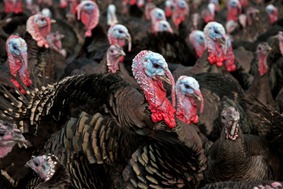Our Christmas Turkeys, Eaten with a Grain of Shame
 While few of us are ready to give up the Christmas turkey, as environmentalists we’re going to have to admit that most of us, who will consume 40-million of these birds in the U.S. this season, are not choosing a Christmas dinner that’s in the best interests of the planet. We’re not talking to the few who raised their own bird, or managed to buy it from a local farmer. They are the exception.
While few of us are ready to give up the Christmas turkey, as environmentalists we’re going to have to admit that most of us, who will consume 40-million of these birds in the U.S. this season, are not choosing a Christmas dinner that’s in the best interests of the planet. We’re not talking to the few who raised their own bird, or managed to buy it from a local farmer. They are the exception.
Oh, but,” you say, “I only buy free-range and/or organically fed turkeys. I am a good and ecologically correct person (even if you are not).”
While free-range, organic birds do produce slightly less greenhouse gases than the factory raise kinds, they still suffer from the problems that make the energy cost of our food ten times higher than the joules of energy we get out of it.
Turkeys join other fowl and meat from four-footed animals as generating a disproportionate amount of greenhouse gases. As the Guardian reported (see the article in our news feed from October 14th), armed creatures generate more methane from their burps than from any other source. In addition, since most animals raised for food, including most turkeys, are grown in factory farms, their excrement is retained in ponds rather than being used as locally as fertilizer. The collective result from all those ponds is to generate vast amounts of methane. So while the animals are alive, they are burning the atmosphere at both ends. Finally, transporting all those animals to slaughterhouses and then shipping the butchered carcasses to your supermarket involves millions of gallons of gasoline and motor oil that is burned and sent right up into the atmosphere.
Although the locavorean ethic has made great inroads in the upper middle class consciousness, encouraging a significant amount of local agricultural acitivity, it still remains the proverbial drop in the gigantic bucket of food production and consumption, even if you just consider the U.S. alone. We are currently consuming some 75 million tons of food a year, while wasting 30 tons (40 per cent) because it isn’t pretty enough to go on the shelves, is trimmed off, or is discarded unused as garbage.
In addition to the food we produce for human consumption, we grow enough grain for livestock (including, of course, turkeys) to feed another 800 million people. The cost is enormous, not only in the fact that so many more humans go hungry because the diversion of grain for feed raises food prices across the board, but in terms of a profligate use of energy. It is true that, compared to meat from four-legged animals, the energy cost of turkey is much lower. The ratio of energy required to grow beef or lamb for our table is some 50 times the protein energy we get out of it. For turkey the energy ratio is only 13 to 1. For us turkey eaters, that will have to do.


